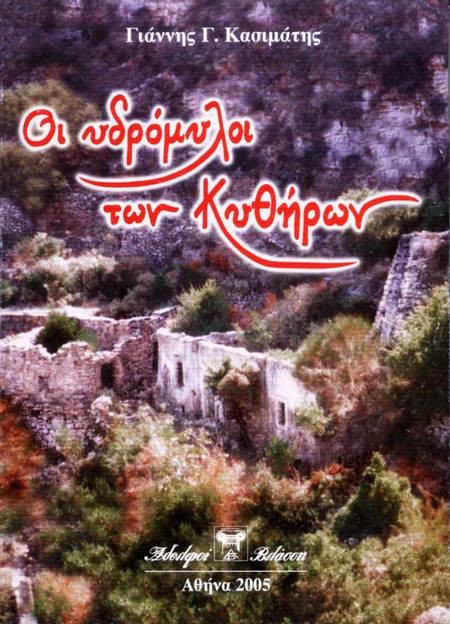The Water Mills of Kythera.

Author: Ioannis Γ Kasimatis
Author's Tel., Athens: 210 90 10 320
When Published: 2005
Publisher: Athelfi (Brothers) Vlassi
Λόντου 2-4
Aθήνα. 106 81
Tηλ: 210 38 12 900, 210 38 33 013
Fax: 210 38 27 557
www.vlassi.gr
Language: Greek
Available: Bookshop at Kondolianika, Kythera
Email, here
Description: 133 page, paperback edition
ISBN: 960-302-231-4
A Book Review
The Kytherian, Newsletter of the Kytherian Association of Australia, Sydney, January 2006, page 9.
The quaint village of Milopotamos on Kythera is famous for its running water and waterfalls. Less known is the large number of old water mills which once operated in this little village and from which the town derives its name.
The well known Kytherian author, Ioannis Cassimatis, has recently published an interesting and very readable book in Greek, The Water Mills of Kvthera (Bros. Vlassi, Athens, 2005), tracing the history and location of over 80 water mills on the island, of which 22 alone can be found in Milopotamos.
Water mills date back to early times and in the preindustrial era were a popular way of grinding and milling grains. The force of the running water propelled the water wheel which transferred the water’s power to a drive-shaft which turned the large mill stones.
According to Cassimatis, the first water wheels appeared in Kythera in the late eighteenth century. It is thought they were introduced from Crete where mil!s were built during the Ottoman and Venetian occupations. Traditionally, the mills, which were either single or two storey buildings, were built in the prevailing architectural style of the village. The author has studied all of the mills on Kythera and presents a summary of the location and type of each mill on the island.
His account of the mills in Milopotamos is particularly interesting as the second mill, known as the “Egglezianika” (or English mill) was last operated by my late grandfather, Theodoros Poteris, until 1944. According to Kytherian folklore, the famous resistance fighter, Theodoros Kolokotronis, often hid in this mill whilst he was on the island.
Cassimatis explains that the mills, apart from their commercial purpose, also served to promote social discourse among the islanders. The local kotsobolio was often generated by locals and people from other parts of the island coming together at the mills.
Apart from Milopotamos, the author notes that there are 10 mills in Karavas. The fourth mill is in fact located near the house belonging to the “Tzortzopoulianikon” (the Poulos clan), near the Keramariou well.
In the verdant town of Mitata, there are 9 mills including the “Karapati” mill operated by Ioannis Prineas until the end of the nineteenth century. Sadly the last water mill on Kythera ceased to operate in the late 1940's as the advent of power on the island meant that the mills were no longer economical to operate.
The water mills of Kythera now stand silent and unfortunately are in varying stages of decay. They are a stark reminder of a bygone era and it is hoped that at least one of these mills can be restored in the future to ensure that their legacy in the island’s rich tapestry of culture and history is preserved.
George Vardas